The black and yellow garden spider is one of the most recognizable orb-weavers found across North America. Known for its striking stripes and impressive web patterns, this spider attracts attention because of its unusually large size, especially among females. Understanding how big these spiders grow, what factors influence their size, and how their growth stages work helps explain why they play such an important role in gardens and natural landscapes.
Overview of the Black and Yellow Garden Spider

The black and yellow garden spider (Argiope aurantia) is a visually distinctive species often seen decorating gardens, fences, and sunny vegetation. Its bright colors, orb-shaped web, and bold presence make it easy to spot during the warm months. Females are far larger and more noticeable than males, while juveniles display early patterns that develop more clearly as they grow. Because of their size and visibility, these spiders often spark curiosity from homeowners and nature observers.
Size of the Black and Yellow Garden Spider

The size of this species is its most defining feature, with females reaching impressive dimensions and males remaining significantly smaller. Their growth depends on several environmental factors, ranging from diet to climate, and each life stage reveals noticeable changes in size and shape.
Adult Female Size
Adult female black and yellow garden spiders are known for their substantial body length and long, flexible legs. They typically measure 19–28 mm in body length, with legspans that can spread much wider across their webs. In late summer and early fall, females reach their maximum size after completing several molts. Their larger bodies also support egg production, making size an essential part of their reproductive success.
Adult Male Size
Males are much smaller, usually measuring 5–8 mm in body length. Their reduced size allows them to move easily around the female’s web without attracting too much attention. Compared to the brightly colored females, males are darker and thinner, often going unnoticed unless they are spotted sitting near the edge of a larger web. Their size plays a role in survival, as a smaller body helps them avoid aggression from females during mating attempts.
Juvenile vs. Adult Sizes
Juvenile garden spiders start life extremely small, emerging from egg sacs as tiny spiderlings that disperse by ballooning. Through multiple molts, their size increases steadily. By midsummer, juveniles show clear patterns but remain much smaller than mature individuals. Their final size depends on the number of molts completed and the availability of food. Only by late summer do females start reaching the iconic large size that makes them easily recognizable.
Factors Influencing Size
Several factors affect how large black and yellow garden spiders grow:
- Food Availability: A steady diet of insects allows for faster growth and larger adult size.
- Habitat Quality: Sunny, sheltered spaces promote successful web building and more frequent feeding.
- Climate and Temperature: Warm conditions speed up growth and molting cycles.
- Predators and Stress: Areas with high predation may limit growth opportunities for juveniles.
These factors work together to determine the overall size of each spider, with ideal conditions supporting the largest individuals.
Identification Features

Body Color and Patterns
- Bright yellow and black abdominal stripes
- Silvery-white cephalothorax
- Females show bolder, clearer markings
- Males display muted brown and yellow tones
Web Characteristics
- Large orb-shaped web structure
- Prominent zigzag stabilimentum (“writing”)
- Webs often built in sunny, open spaces
- Strong silk strands capable of holding larger prey
Behavior Linked to Size
- Females remain centered on webs
- Males stay near outer edges
- Rapid prey-wrapping movements
- Defensive but non-aggressive behavior
Habitat and Geographic Range

The black and yellow garden spider thrives in sunny outdoor spaces, favoring locations where tall plants or man-made structures provide support for their large orb webs. They are commonly found in gardens, meadows, agricultural fields, and along wooded edges. These environments offer stable surfaces for web building and a consistent supply of insects.
Typical Locations
They prefer open, bright areas with minimal disturbance. Fences, porch corners, tall grasses, and flowering gardens are ideal because these spots allow enough airflow for insects to move through while offering strong anchors for their webs. Home gardens often provide perfect conditions, making sightings frequent in late summer and early fall.
Distribution
This species is widespread across North America, from southern Canada down through the United States and into parts of Mexico. Populations are especially dense in warm, humid regions where vegetation grows thickly throughout the year. Larger individuals are often reported in southern states, where longer warm seasons support extended growth.
Life Cycle and Development

The life cycle of the black and yellow garden spider includes distinct stages, each marked by growth and visible changes in size. Understanding their development helps explain why individuals vary so much in appearance and maturity throughout the season.
Egg to Spiderling
Females lay hundreds of eggs inside round, papery egg sacs that may measure up to an inch in diameter. Each sac can contain several hundred spiderlings. After hatching, the young remain within the sac until spring, emerging as tiny spiderlings ready to disperse. Their size at this stage is extremely small, barely visible without close inspection.
Molting and Growth Stages
As the spiderlings mature, they undergo multiple molts, shedding their exoskeleton to allow for growth. Each molt results in a noticeable increase in size, with females expanding more rapidly than males. Molting continues through spring and summer, with the largest size gains occurring when food is abundant and temperatures remain warm.
Adult Maturity
Garden spiders reach adulthood by mid-to-late summer. Females achieve full body size shortly before breeding, while males mature earlier and spend much of their time locating potential mates. The size difference becomes most obvious during this stage, as females tower over the much smaller males that linger cautiously around the outer edges of their webs.
Role of Size in Hunting and Web-Building

The black and yellow garden spider’s size directly influences its hunting success, web construction, and overall behavior. Larger individuals are capable of capturing larger prey and building stronger, more expansive webs.
How Size Affects Prey Capture
A large female can subdue big insects, including grasshoppers, cicadas, and even small dragonflies. Their long legs allow them to maneuver swiftly along the web, wrapping prey with speed and precision. The strength and length of their legs provide significant leverage, helping them secure struggling insects before feeding.
How Web Size Reflects Spider Size
Web dimensions are closely linked to the spider’s overall size. Larger spiders create wider webs with thicker silk strands, allowing them to withstand the force of heavier prey. These webs are often rebuilt or repaired each day, ensuring maximum effectiveness. The zigzag stabilimentum also tends to be thicker in webs constructed by larger females.
Safety, Bites, and Interaction with Humans

Black and yellow garden spiders are often seen near homes, which can lead to questions about safety. Despite their intimidating appearance, they are generally harmless to humans and benefit outdoor spaces by reducing pest populations.
Are They Dangerous?
Their venom is mild and not medically significant to humans. Bites typically occur only if the spider is handled or threatened. Even then, symptoms are minor—similar to a bee sting. Their large size may seem alarming, but their behavior is defensive rather than aggressive, making them safe garden companions.
Benefits to Gardens
These spiders play a valuable role in controlling insect pests. Their large webs capture flies, beetles, grasshoppers, and other insects that commonly damage plants. The combination of their size, hunting efficiency, and daily web maintenance allows them to regulate pest populations naturally, supporting healthy garden ecosystems.
Comparison Table: Male vs. Female Size
| Feature | Female | Male |
| Body Length | 19–28 mm | 5–8 mm |
| Legspan | Significantly larger | Much smaller |
| Coloration | Bright yellow and black | Muted brown and yellow |
| Web Role | Primary builder | Hovers at edges |
| Behavior | Defensive, stationary | Mobile, cautious |
FAQs
How big can a black and yellow garden spider get?
Adult female garden spiders commonly reach body lengths of 19–28 millimeters, and their extended legspan makes them appear even larger. Males, by contrast, remain quite small at around 5–8 millimeters. Size peaks in late summer after several molts, allowing the spiders to reach their largest and most recognizable form.
Why are the females so much larger than the males?
The size difference is due to sexual dimorphism, a common trait in orb-weaver spiders. Females require larger bodies to support egg development and build extensive webs. Males stay small to remain agile, conserve energy, and reduce the chance of being noticed—or attacked—while approaching females during mating.
Does their size make them more dangerous to humans?
No, their size does not increase their level of danger. Although females appear intimidating because of their large bodies and striking colors, their venom is weak and generally harmless to people. They rarely bite unless touched or threatened, and even then, symptoms are mild and usually short-lived.
When do they reach their largest size?
Black and yellow garden spiders reach their maximum size in late summer through early fall. This period follows months of consistent feeding, warm temperatures, and multiple molts. By the time mating season begins, females have grown to their fullest dimensions, making them especially noticeable in garden landscapes.
Does location affect how big they grow?
Yes, environmental factors such as climate, prey availability, and habitat quality influence their size. Spiders in warmer regions often grow larger because they experience longer feeding seasons. Areas with abundant insect populations also support faster growth, allowing individuals to reach their full potential by the end of summer.


